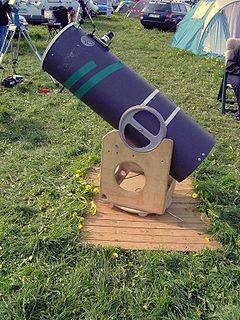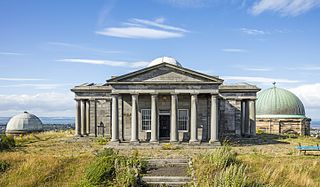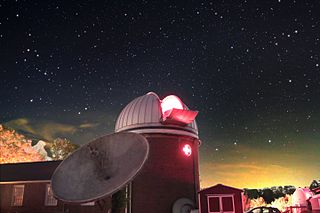
The Dominion Astrophysical Observatory, located on Observatory Hill, in Saanich, British Columbia, was completed in 1918 by the Canadian government. The Dominion Architect responsible for the building was Edgar Lewis Horwood. The main instrument is the 72 inch aperture Plaskett telescope, proposed and designed by John S. Plaskett in 1910 with the support of the International Union for Cooperation in Solar Research.

An altazimuth or alt-azimuth mount is a simple two-axis mount for supporting and rotating an instrument about two perpendicular axes – one vertical and the other horizontal. Rotation about the vertical axis varies the azimuth of the pointing direction of the instrument. Rotation about the horizontal axis varies the altitude of the pointing direction.

The Kopernik Observatory & Science Center (KOSC), is a public observatory in Vestal, New York opened to the public on 16 June 1974 by the Kopernik Society of Broome County to commemorate the 500th anniversary of the birth of the astronomer Nicolaus Copernicus in 1973. Its mission is to offer hands-on investigations and outreach programs for educating all ages about astronomy and science using advanced optical telescopes, computers and other tools. It is the first science laboratory facility in New York State designed for K-12 teachers, students and their families, and has been one of the best-sited and best equipped public observatories in the Northeast United States for nearly the last 40 years.

The City Observatory is an astronomical observatory on Calton Hill in Edinburgh, Scotland. It is also known as the Calton Hill Observatory.

Custer Observatory is an astronomical observatory owned and operated by Custer Institute. Located in Southold, New York (US), facing Peconic Bay and Shelter Island, Custer's location boasts some of the darkest skies on Long Island.

Warren Rupp Observatory is an astronomical observatory owned and operated by Richland Astronomical Society. Built in 1985, it is located on the Friendly House Hidden Hollow Camp south of Mansfield, Ohio (USA).

Green Point Observatory is a private observatory in Oyster Bay, Sydney, Australia, and is the home of the Sutherland Astronomical Society. It is located at the corner of Green Point and Caravan Head Roads. It consists of a dome, library, 41 centimetres (16 in) Newtonian telescope, a meeting hall seating 100 people, and a roll-off roof observatory with a 35 centimetres (14 in) Schmidt Cassegrain Telescope. The observatory is used by members of the society for observing stars and eclipses, research, astro imaging as well as hosting public education courses and monthly open nights.

Melbourne Observatory was founded in 1862 to serve as a scientific research institution for the rapidly growing city of Melbourne, the capital of the colony of Victoria. The observatory was tasked by the Victorian government with maintaining an accurate time reference for the colony through observations of stars using a transit telescope as well as general astronomical research.

The Mills Observatory in Dundee, Scotland, is the first purpose-built public astronomical observatory in the UK. Built in 1935, the observatory is classically styled in sandstone and has a distinctive 7 m dome, which houses a Victorian refracting telescope, a small planetarium, and display areas. The dome is one of two made from papier-mâché to survive in the UK, the other being at the Godlee Observatory.

Fuertes Observatory is an astronomical observatory located on the North Campus of Cornell University in Ithaca, New York. The observatory was designed by L.P. Burnham, Cornell Professor of Architecture and completed in fall of 1917. It was originally used by the Civil Engineering Department as an instructional field office for navigation and surveying. Today, the observatory is primarily used for public outreach, welcoming over two thousand visitors per year with open houses on clear Friday nights.
Mansfield and Sutton Astronomical Society (MSAS) is an amateur astronomical society in the East Midlands of England. It was formed in 1969. It is based at Sherwood Observatory, a 61 cm mirror telescope which it owns and operates. The observatory lies 4 km south west of the centre of Mansfield on one of the highest points in the county of Nottinghamshire.

J A Jones Hoober Observatory is a privately owned observatory located in South Yorkshire, England near to the villages of Hoober and Wentworth, 4 miles (6.4 km) North-northwest of Rotherham. It can be found about 300 metres (0.19 mi) east of Hoober Stand. The observatory is owned and operated by Mexborough & Swinton Astronomical Society (NPO).

Powell Observatory is an astronomical observatory located near Louisburg in Miami County, Kansas. It features several large telescopes and is available for public viewing, for private use of Astronomical Society of Kansas City members, and for ongoing research projects.

The Great Melbourne Telescope was built by Thomas Grubb in Dublin, Ireland in 1868, and installed at the Melbourne Observatory in Melbourne, Australia in 1869. In 1945 that Observatory closed and the telescope was sold and moved to the Mount Stromlo Observatory near Canberra. It was rebuilt in the late 1950s. In 2003 the telescope, still in use as an observatory, was practically destroyed in a severe bushfire in the area, but a project to restore it to working condition is under way in the 2010s.

The Dark Sky Observatory (DSO) is an astronomical observatory owned and operated by Appalachian State University (ASU). It is located 9 kilometers (5.6 mi) east of Deep Gap, North Carolina (USA), off of the Blue Ridge Parkway, and 32 kilometers (20 mi) east of the ASU campus in Boone, North Carolina It was established in 1981, and is used for research, instruction, and public viewing events. The Cline Visitors' Center was completed in 2011.
Sheep Hill Observatory is an Astronomical observatory located in Morris County, New Jersey. It features an 18-inch (457mm) Newtonian reflecting telescope and is open to the public on the 3rd Friday evening of each month, weather permitting. It is also made available to Schools, Scouting Groups and other educational groups upon request.
The Astronomy Centre, also known as the Amateur Astronomy Centre, is an astronomical observatory located in northern England which is run by experienced amateur astronomers and is open to the public at certain times.

The Milwaukee Astronomical Society (MAS) is a 501(c)(3) tax-exempt organization serving amateur astronomers in the greater Milwaukee area since 1932, making it one of the oldest continuously running astronomy clubs in the nation. The MAS operates an observatory, one of the largest amateur club observatories in the world. The current membership is 175.

The Linden Observatory Complex is a heritage-listed former observatory and manufacture of optical precision implements and now residence, museum, observatory, education facility and meeting venue located at 91 – 111 Glossop Road, Linden, City of Blue Mountains, New South Wales, Australia. It was designed and built by Ken Beames from 1938 to 1948. It is also known as K Beames Engineering Co. The property is owned by the Linden Observatory Trust. It was added to the New South Wales State Heritage Register on 5 March 2010.

The Greenwich 28-inch refractor is a telescope at the Royal Observatory, Greenwich, where it was first installed in 1893. It is a 28-inch ( 71 cm) aperture objective lens telescope, otherwise known as a refractor, and was made by the telescope maker Sir Howard Grubb. The achromatic lens was made Grubb from Chance Brothers glass. The mounting is older however, and dates to the 1850s designed by Royal Observatory director George Airy and the firm Ransomes and Simms. The telescope is noted for its spherical dome the extends beyond the tower, nicknamed the "onion" dome. Another name for this telescope is "The Great Equatorial" which it shares with the building, which housed an older but smaller telescope previously.

















